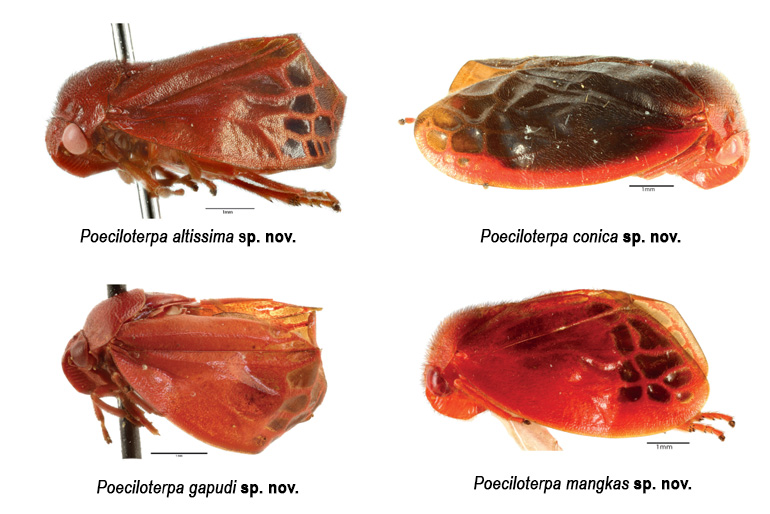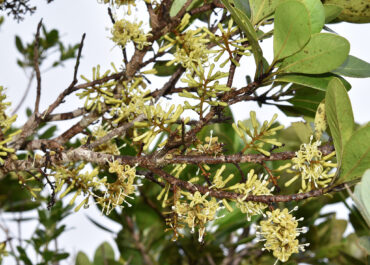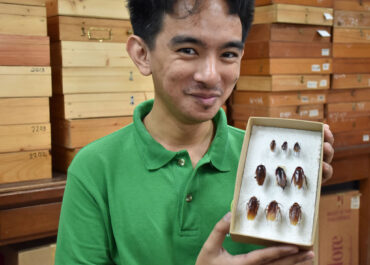
If you are a curious outdoors person, you may at least once have come across frothy slime smeared on vegetation. Your first thought may have been, “Gross! How could anyone spit around so carelessly?”
But the chances of you touching another persons’ sputum even on a hike are quite small. Spittlebugs might be the more likely culprit.
Bugs that spit and hop
That ‘spit’ you were shaking off your hand could be the secretion of a sap-feeding cercopid called a froghopper.
“Cercopids are a big family of tiny hemipterans, an insect group which has wings that are part tough and hard, part membranous,” explains Dr. Sheryl A. Yap, curator at the UPLB Museum of Natural History.
“Adult froghoppers can jump high and far, many times their height and length. Hence, the reference to their common name,” describes Yap, who is also director of the Institute of Weed Science, Entomology and Plant Pathology at the University of Philippines Los Baños. “But one notable thing about froghoppers is that their nymphs, also called ‘spittlebugs,’ produce a spit-like substance, which is likely what you had accidentally touched in the field.”
“But, of course, it’s possible it could be someone’s spit after all,” she grins.
The foam is not actually spittle, researchers have found, but a sticky bubbly mass produced by the froghopper nymphs by pumping air from their abdomen into the urine they have just expelled. Scientists say the spittlebugs cover themselves with the froth as some form of protection against predators and extreme temperatures.
Four new species added to endemic froghoppers
The family Cercopidae has around 1,500 species named and described but studies indicate the group is still one of the most neglected and unexplored. In the Philippines, 67 species of cercopids, belonging to 18 genera, have been found. Some of these genera are endemic to the country.
“The genus Poeciloterpa Stål, 1870, which is the focus of our work, has been found only in the islands of Luzon, Mindanao, Negros, Panay, and Polillo,” shares Elorde Crispolon, Jr., one of Yap’s graduate mentees.
Crispolon and Yap, who collaborated with Adeline Soulier-Perkins of the Paris-based Museum National d’Histoire Naturelle to review the list of froghoppers belonging to Poeciloterpa, have been able to describe four new species.
In an article released in Zootaxa 4608 (2), the researchers announced the description of P. altissima Crispolon and Soulier-Perkins sp. nov., P. conica Crispolon and Soulier-Perkins sp. nov., P. gapudi Crispolon and Yap sp. nov., and P. mangkas Crispolon and Yap sp. nov. From only nine known species previously, Poeciloterpa now has 13.
“We went on collection trips as well as inspected very old collections, even those collected nearly a century ago by former UP College of Agriculture Dean Charles Baker,” lead author Crispolon explained via email. Their group also looked at important collections in museums in Poland, France, United Kingdom, Sweden, and Germany.
Honoring a great entomologist
P. gapudi is named after Dr. Victor P. Gapud, a renowned Filipino entomologist and taxonomist and former director of the UPLB Museum of Natural History (MNH). “The holotype material, incidentally, was collected by Dr. Stephen G. Reyes, also a former director of the MNH, at Mt. Kitanglad in May 1984,” Dr. Yap explains.
The species was named after Gapud in recognition of his great contributions in describing the Philippine entomofauna.
Search
Archives
Categories
- Announcement (21)
- Feature (21)
- News (141)
- Press Release (55)
- Research (4)
- Services (3)



